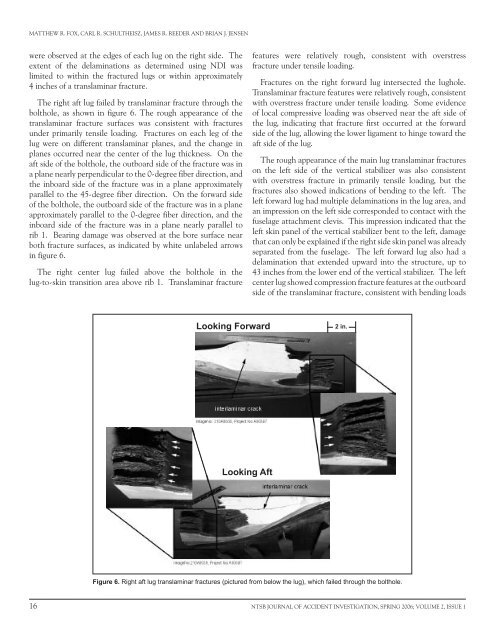Journal of Accident Investigation
Journal of Accident Investigation
Journal of Accident Investigation
Create successful ePaper yourself
Turn your PDF publications into a flip-book with our unique Google optimized e-Paper software.
MATTHEW R. FOX, CARL R. SCHULTHEISZ, JAMES R. REEDER AND BRIAN J. JENSEN<br />
were observed at the edges <strong>of</strong> each lug on the right side. The<br />
extent <strong>of</strong> the delaminations as determined using NDI was<br />
limited to within the fractured lugs or within approximately<br />
4 inches <strong>of</strong> a translaminar fracture.<br />
The right aft lug failed by translaminar fracture through the<br />
bolthole, as shown in figure 6. The rough appearance <strong>of</strong> the<br />
translaminar fracture surfaces was consistent with fractures<br />
under primarily tensile loading. Fractures on each leg <strong>of</strong> the<br />
lug were on different translaminar planes, and the change in<br />
planes occurred near the center <strong>of</strong> the lug thickness. On the<br />
aft side <strong>of</strong> the bolthole, the outboard side <strong>of</strong> the fracture was in<br />
a plane nearly perpendicular to the 0-degree fiber direction, and<br />
the inboard side <strong>of</strong> the fracture was in a plane approximately<br />
parallel to the 4 -degree fiber direction. On the forward side<br />
<strong>of</strong> the bolthole, the outboard side <strong>of</strong> the fracture was in a plane<br />
approximately parallel to the 0-degree fiber direction, and the<br />
inboard side <strong>of</strong> the fracture was in a plane nearly parallel to<br />
rib 1. Bearing damage was observed at the bore surface near<br />
both fracture surfaces, as indicated by white unlabeled arrows<br />
in figure 6.<br />
The right center lug failed above the bolthole in the<br />
lug-to-skin transition area above rib 1. Translaminar fracture<br />
features were relatively rough, consistent with overstress<br />
fracture under tensile loading.<br />
Fractures on the right forward lug intersected the lughole.<br />
Translaminar fracture features were relatively rough, consistent<br />
with overstress fracture under tensile loading. Some evidence<br />
<strong>of</strong> local compressive loading was observed near the aft side <strong>of</strong><br />
the lug, indicating that fracture first occurred at the forward<br />
side <strong>of</strong> the lug, allowing the lower ligament to hinge toward the<br />
aft side <strong>of</strong> the lug.<br />
The rough appearance <strong>of</strong> the main lug translaminar fractures<br />
on the left side <strong>of</strong> the vertical stabilizer was also consistent<br />
with overstress fracture in primarily tensile loading, but the<br />
fractures also showed indications <strong>of</strong> bending to the left. The<br />
left forward lug had multiple delaminations in the lug area, and<br />
an impression on the left side corresponded to contact with the<br />
fuselage attachment clevis. This impression indicated that the<br />
left skin panel <strong>of</strong> the vertical stabilizer bent to the left, damage<br />
that can only be explained if the right side skin panel was already<br />
separated from the fuselage. The left forward lug also had a<br />
delamination that extended upward into the structure, up to<br />
43 inches from the lower end <strong>of</strong> the vertical stabilizer. The left<br />
center lug showed compression fracture features at the outboard<br />
side <strong>of</strong> the translaminar fracture, consistent with bending loads<br />
Looking Forward 2 in.<br />
Looking Aft<br />
Figure 6. Right aft lug translaminar fractures (pictured from below the lug), which failed through the bolthole.<br />
16 NTSB JOURNAL OF ACCIDENT INVESTIGATION, SPRING 2006; VOLUME 2, ISSUE 1
















